预备知识:
map和hashmap的区别:
| hashmap(unordered_map) | map |
|---|---|
| 底层为哈希表 | 底层为红黑树 |
| 非按键排序 | 按键排序 |
| 查找效率为O(1) | 查找效率为O(logn) |
| 插入的时间是O(logn) | 插入的时间是O(logn) |
| key只能是int、double等基本类型以及string | 支持所有类型的键值对 |
共同点:
键都不能重复
用法类似
例题:
(1)1、两数之和–知道目标值,找下标–简单
给定一个整数数组 nums 和一个整数目标值 target,请你在该数组中找出 和为目标值 target 的那 两个 整数,并返回它们的数组下标。
你可以假设每种输入只会对应一个答案。但是,数组中同一个元素在答案里不能重复出现。
你可以按任意顺序返回答案。
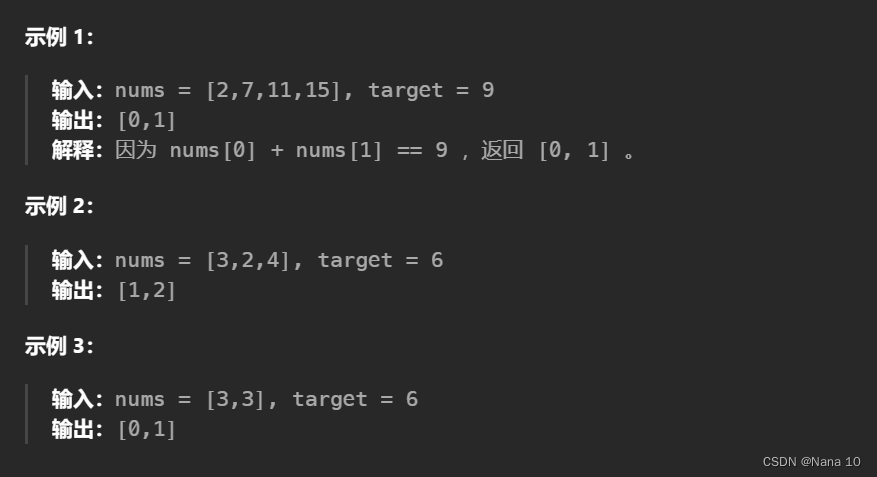
#include <vector>
#include <unordered_map>
using namespace std;
class Solution {
public:
vector<int> twoSum(vector<int>& nums, int target) {
unordered_map<int, int> hash; // 哈希表用于记录数字对应的下标
for (int i = 0; i < nums.size(); ++i) {
//寻找hashmap中是否有与当前元素互补的元素
int n = nums[i];
int complement = target - n;
//如果有两个相同的元素之和为target,计算前再插入,无影响
if (hash.count(complement)) {
return {
hash[complement], i}; // 找到答案,返回下标对
}
hash[n] = i; // 记录数字对应的下标
}
return {
}; // 找不到答案,返回空数组
}
};
(2)12整数转罗马数字 --,需要从大到小遍历,所以用的map–中等
罗马数字包含以下七种字符: I, V, X, L,C,D 和 M。
字符 数值
I 1
V 5
X 10
L 50
C 100
D 500
M 1000
例如, 罗马数字 2 写做 II ,即为两个并列的 1。12 写做 XII ,即为 X + II 。 27 写做 XXVII, 即为 XX + V + II 。
通常情况下,罗马数字中小的数字在大的数字的右边。但也存在特例,例如 4 不写做 IIII,而是 IV。数字 1 在数字 5 的左边,所表示的数等于大数 5 减小数 1 得到的数值 4 。同样地,数字 9 表示为 IX。这个特殊的规则只适用于以下六种情况:
I 可以放在 V (5) 和 X (10) 的左边,来表示 4 和 9。
X 可以放在 L (50) 和 C (100) 的左边,来表示 40 和 90。
C 可以放在 D (500) 和 M (1000) 的左边,来表示 400 和 900。
给你一个整数,将其转为罗马数字。
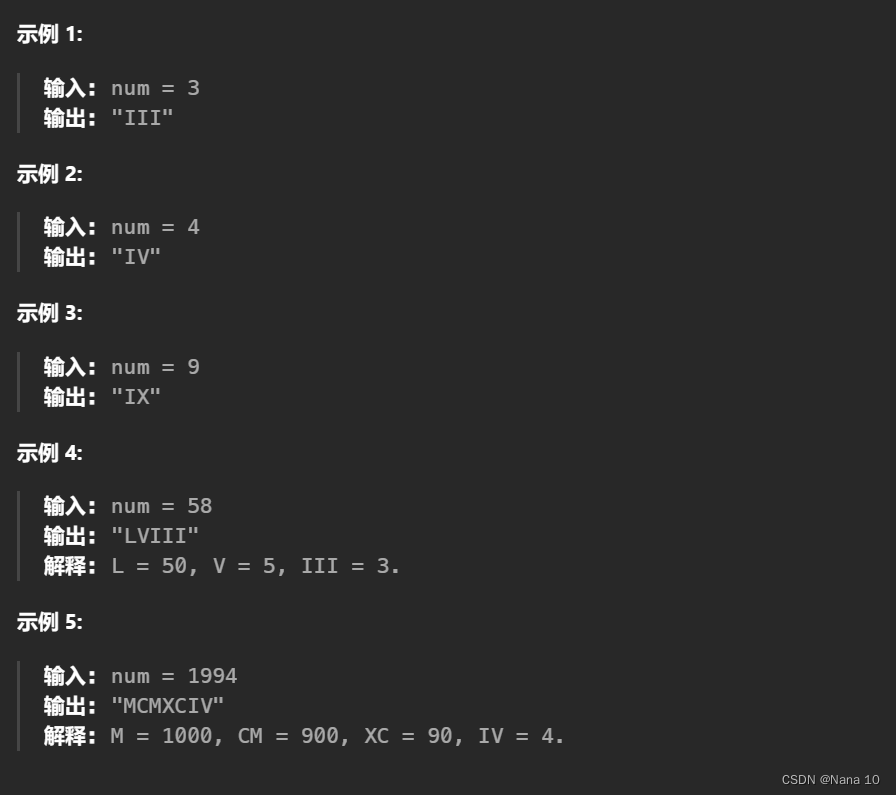
其它知识点:
map从大到小遍历:
方法(1)重载 () 运算符
①重载 () 运算符,接收两个元素参数,返回一个 bool 类型的比较结果。
②在定义 std::map 或其他关联容器时,将该比较函数对象作为模板参数传入,以覆盖默认的元素比较方式。
#include <iostream>
#include <map>
// 定义一个比较函数对象,按照元素值大小从大到小排序
class GreaterValue {
public:
bool operator()(const std::pair<int, int>& p1, const std::pair<int, int>& p2) const {
return p1.second > p2.second;
}
};
int main() {
// 定义一个 map,键值类型为 int,值类型为 int
std::map<int, int, GreaterValue> myMap;
// 插入一些元素
myMap.insert({
3, 10});
myMap.insert({
1, 20});
myMap.insert({
2, 30});
// 遍历 map,输出每个元素
for (const auto& elem : myMap) {
std::cout << elem.first << " => " << elem.second << '\n';
}
return 0;
}
方法(2)利用反迭代器
使用迭代器逆序遍历 map 可以利用反向迭代器 rbegin() 和 rend() 来实现。具体的方法是:对于普通迭代器,我们可以使用前缀自增运算符 ++ 来向前移动迭代器查找 map 元素,而对于反向迭代器,则需要使用前缀自减运算符 – 来向后移动迭代器查找 map 元素
实现中利用了方法(2)
class Solution {
public:
string intToRoman(int num) {
string result;
map<int, string> intToRomanStr = {
{
1, "I"}, {
4, "IV"}, {
5, "V"}, {
9, "IX"},
{
10, "X"}, {
40, "XL"}, {
50, "L"}, {
90, "XC"},
{
100, "C"}, {
400, "CD"}, {
500, "D"}, {
900, "CM"},
{
1000, "M"}};
//逆序遍历map,用反向迭代器
auto it = intToRomanStr.rbegin();
//cout<< " it.first = "<< (*it).first << " it.second = "<< (*it).second;
while(num > 0){
//cout<< "num = " << num;
for(; it != intToRomanStr.rend() && (num < (*it).first);it++){
};
//it指向num第一个大于的数字
//cout<< " it.first = "<< (*it).first << " it.second = "<< (*it).second;
int times = num/(*it).first;
while(times > 0) {
result+=(*it).second;
times--;
}
num = num%(*it).first;
//cout<< " remainder = "<< num << endl;
}
return result;
}
};
(3)575分糖果–简单
Alice 有 n 枚糖,其中第 i 枚糖的类型为 candyType[i] 。Alice 注意到她的体重正在增长,所以前去拜访了一位医生。
医生建议 Alice 要少摄入糖分,只吃掉她所有糖的 n / 2 即可(n 是一个偶数)。Alice 非常喜欢这些糖,她想要在遵循医生建议的情况下,尽可能吃到最多不同种类的糖。
给你一个长度为 n 的整数数组 candyType ,返回: Alice 在仅吃掉 n / 2 枚糖的情况下,可以吃到糖的 最多 种类数。
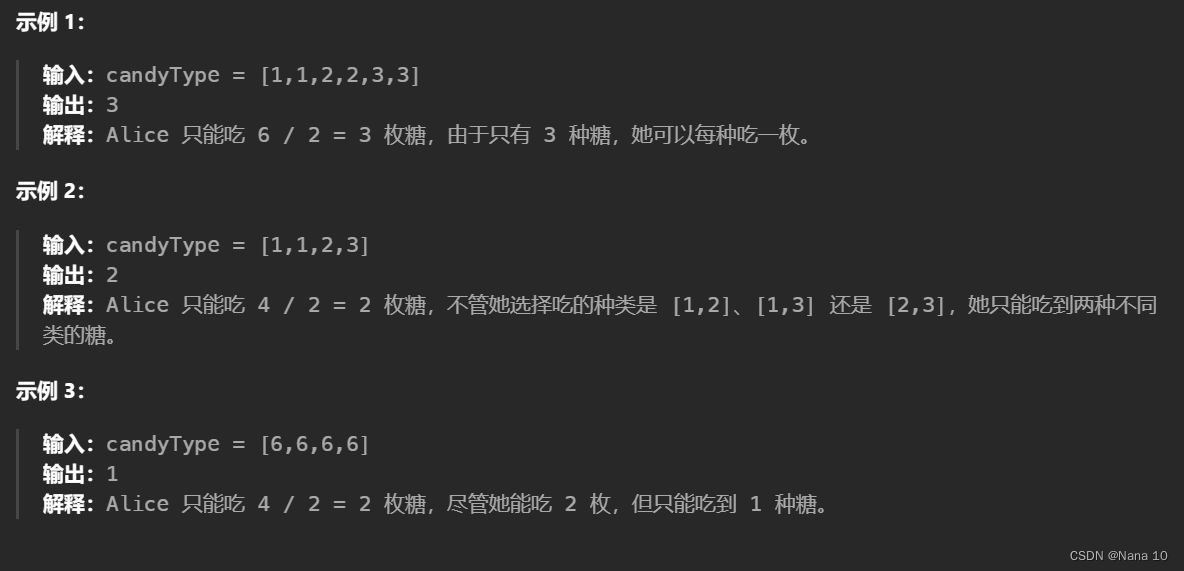
其它知识点
判断unordered_map是否存在某键:
判断vector是否存在某键
//判断unordered_map是否存在某键
unordered_map<int, int> tmp;
插入一些值
if(tmp.find(32) == tmp.end()) cout<<"不存在";
else cout<< "存在";
//判断vector是否存在某键
vector<int, int> tmp;
插入一些值
if(find(tmp.begin(), tmp.end(), 32) == tmp.end()) cout<<"不存在";
else cout<< "存在";
(1)使用unordered_map存储糖果种类
class Solution {
public:
int distributeCandies(vector<int>& candyType) {
unordered_map<int, int> eachTypeNumber;
int typeNum = 0;
int maxEatNum = candyType.size()/2;
//一遍遍历(边遍历边判断),计算糖果的种类及数量
for(auto it:candyType){
int type = it;
if(eachTypeNumber.find(type) == eachTypeNumber.end()){
eachTypeNumber[type] = 0;
typeNum++;
if(typeNum >= maxEatNum) return maxEatNum;
}
eachTypeNumber[type]++;
}
return typeNum;
}
};

(2)使用vector存储糖果种类
class Solution {
public:
int distributeCandies(vector<int>& candyType) {
//存贮种类->数量
vector<int> eachTypeNumber;
int typeNum = 0;
int maxEatNum = candyType.size()/2;
//一遍遍历(边遍历边判断),计算糖果的种类及数量
for(auto it:candyType){
int type = it;
//如果hash表中没有添加过该种类,种类数加一
if(find(eachTypeNumber.begin(), eachTypeNumber.end(), it) == eachTypeNumber.end()){
eachTypeNumber.push_back(it);
typeNum++;
//如果种类数大于等于可以吃的数量,则返回最大可以吃的数量
if(typeNum >= maxEatNum) return maxEatNum;
}
}
//如果全部遍历完种类数还小于可以吃的数量,就返回种类数
return typeNum;
}
};

unordered_map明显比vector快不少
(4)409最长回文串–简单
给定一个包含大写字母和小写字母的字符串 s ,返回 通过这些字母构造成的 最长的回文串 。
在构造过程中,请注意 区分大小写 。比如 “Aa” 不能当做一个回文字符串。
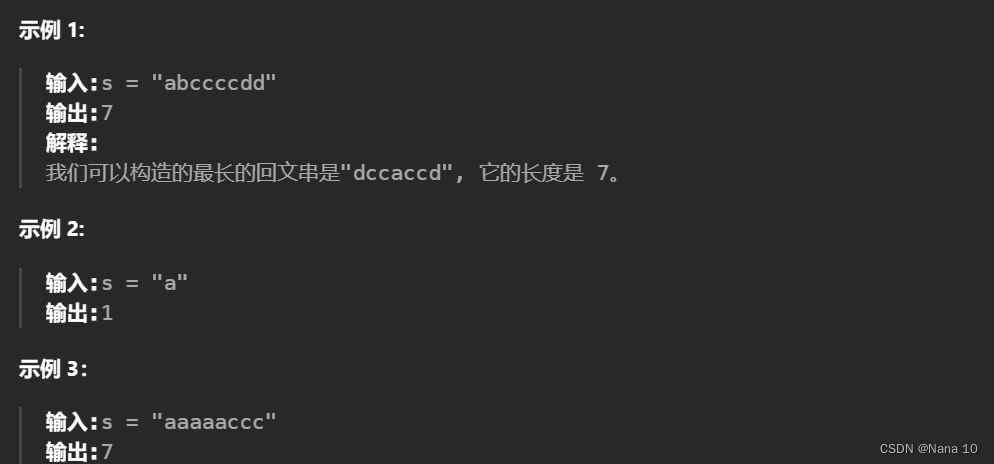
知识点
map数据结构的使用
map的遍历方法
hash函数
代码
class Solution {
public:
int longestPalindrome(string s) {
map<char, int> node_map;
//记录每个字符出现的个数
for(int i = 0; i< s.length(); i++){
if( node_map.find(s[i]) == node_map.end() )
node_map[s[i]] = 0;
node_map[s[i]]++;
}
//迭代器
map<char, int>::iterator it;
int sum = 0;
int mediumFlag = 0;
for(it = node_map.begin(); it != node_map.end(); it++){
//如果该字符出现次数为偶数,则可对称摆放
if(it->second % 2 == 0) sum += it->second;
//如果出现次数为奇数,且未有中间字符,则一个字符放中间,其余对称摆放
else if(mediumFlag == 0) {
sum += it->second;
mediumFlag = 1;
}
//如果出现次数为奇数且已有中间字符,则丢弃一个字符,其余对称摆放
else sum += it->second -1;
}return sum;
}
};
结果
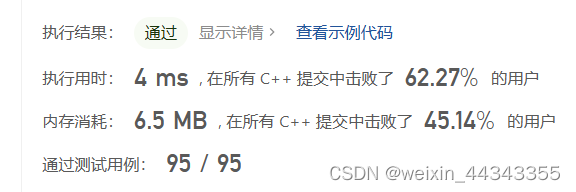
(5)290单词规律–简单
给定一种规律 pattern 和一个字符串 s ,判断 s 是否遵循相同的规律。
这里的 遵循 指完全匹配,例如, pattern 里的每个字母和字符串 s 中的每个非空单词之间存在着双向连接的对应规律。
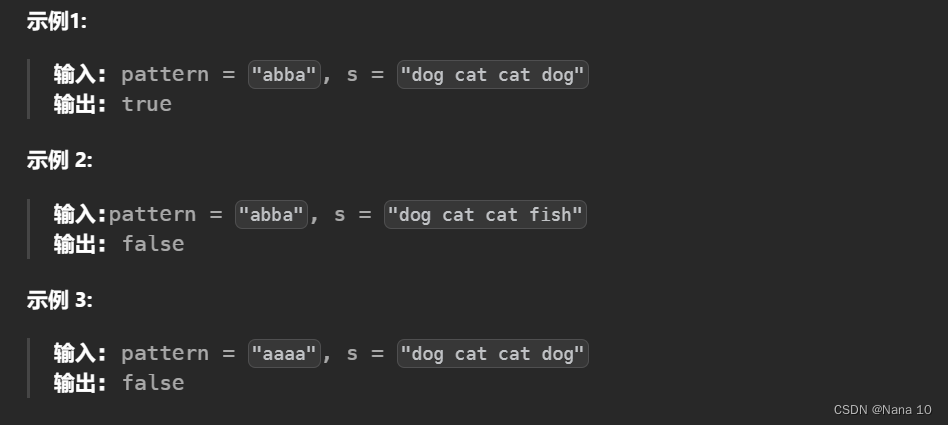
知识点
hash_map
hash_map 的遍历
代码
class Solution {
public:
bool wordPattern(string pattern, string s) {
//字符到单词的映射要唯一
//单词到字符的映射也要唯一
map<char, string> match;
map<string, char> match_str_char;
char patternChar;
int j = 0;
for(int i = 0; i<pattern.length(); i++){
string temp_str = "";
//如果pattern还没遍历结束,s已经遍历结束,则未匹配成功
if(j>= s.length()) return false;
else{
//提取字符串
while(j< s.length() && s[j] != ' '){
temp_str+= s[j];
j++;
}
if(s[j] == ' ') j++;
}
//如果未在字符到单词的映射中找到该字符
if(match.find(pattern[i]) == match.end()){
//添加映射
match[pattern[i]] = temp_str;
//如果在单词到字符的映射中未找到该字符,添加映射
if(match_str_char.find(temp_str) == match_str_char.end()) match_str_char[temp_str] = pattern[i];
//否则,若单词已经对应了其它字符,返回假
else if(match_str_char[temp_str] !=pattern[i]) return false;
}
//否则,若字符已经对应了其它单词,返回假
else if(match[pattern[i]] != temp_str) return false;
}
//如果字符已经遍历完成,单词还未完成,则返回假
if(j < s.length()) return false;
return true;
}
};
提交结果
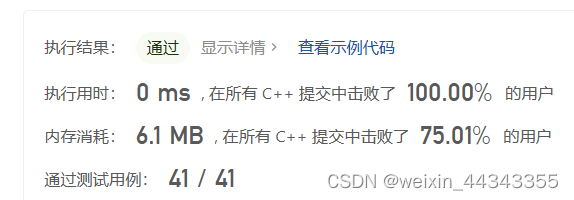
(6)49字母异位词分组–中等
给你一个字符串数组,请你将 字母异位词 组合在一起。可以按任意顺序返回结果列表。
字母异位词 是由重新排列源单词的所有字母得到的一个新单词。

知识点
hash_map
hash_map的遍历
sort函数的使用
字符串排序
代码
class Solution {
public:
vector<vector<string>> groupAnagrams(vector<string>& strs) {
vector<vector<string>> result;
if(strs.size() == 0) return result;
map<string, vector<string>> hash_map;
for(int i = 0; i< strs.size(); i++){
string temp_str = strs[i];
//字符串的排序,组成字符相同的字符串,排序后的结果都是一样的
sort(temp_str.begin(), temp_str.end());
//如果map中没有该字符串,则先添加键
if(hash_map.find(temp_str) == hash_map.end()) {
vector<string> temp;
hash_map[temp_str] = temp;
}
//将字符串push到对应键中
hash_map[temp_str].push_back(strs[i]);
}
map<string, vector<string>>::iterator it;
//hash_map的遍历,将映射完成的,同一组的值push到result中
for(it = hash_map.begin(); it!=hash_map.end(); it++){
result.push_back(it->second);
}
return result;
}
};
结果
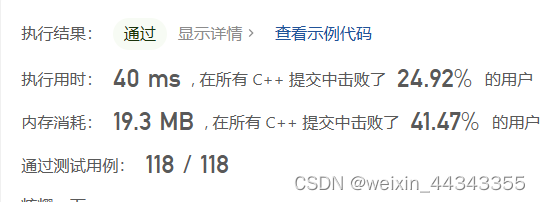
(7)3无重复字符的最长子串–中等
给定一个字符串 s ,请你找出其中不含有重复字符的 最长子串 的长度。
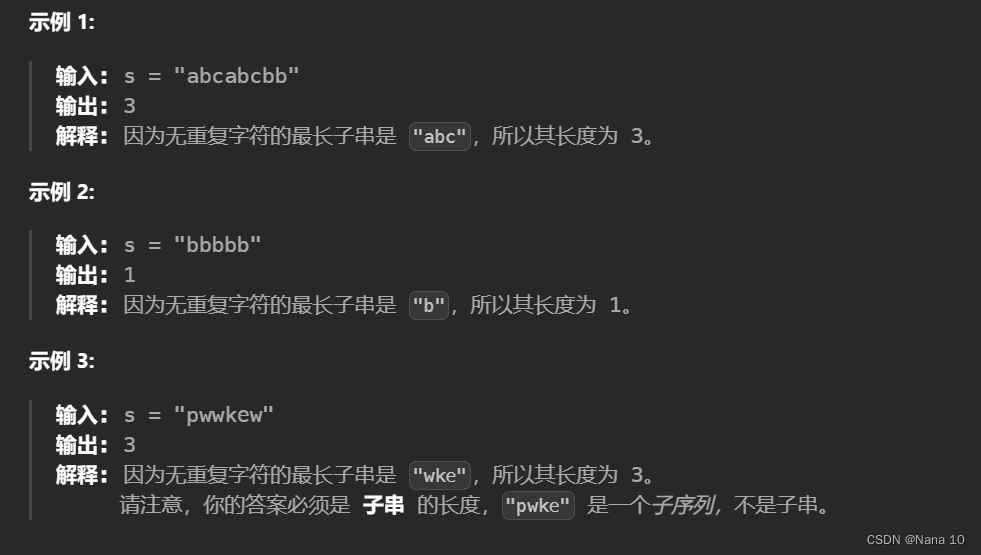
知识点
双指针维护窗口
hash_map
代码
class Solution {
public:
int lengthOfLongestSubstring(string s) {
//双指针维护窗口
int begin = 0;
int end = 0;
int result = 0;
int maxLength = 0;
map<char, int>char_map;
//当end未到达最后时,持续循环
while(end < s.length()){
//cout<<"char_map[s[end]]="<<s[end];
//每向后一个,最长长度加1
maxLength++;
//如果最后字符无重复,将hash表中该字符的映射置为1
if(char_map.find(s[end]) == char_map.end() || char_map[s[end]] == 0) {
//cout<<" "<<char_map[s[end]]<<"+1"<< endl;
char_map[s[end]] = 1;
}
//如果有重复,将begin向后移动,直至无重复为止
else if(char_map[s[end]] == 1){
//cout<<" "<<char_map[s[end]]<<"-1"<<endl;
while(char_map[s[end]] == 1){
char_map[s[begin]] --;
begin++;
maxLength--;
}char_map[s[end]] ++;
}
//如果更新后的最长串大于历史最长串,则更新result
if(maxLength > result) result = maxLength ;
end++;
}
return result;
}
};
结果
